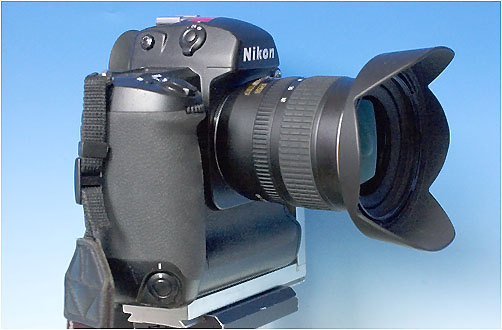 |
|
Not as small as the marketing hype would lead us to believe, but still impressive on its own: AFS 12-24 DX Nikkor |
© Bjørn Rørslett/NN |
| Going Wildly Wide: AFS 12-24 mm f/4 G ED IF DX Nikkor Reviewed | |
| by Bjørn Rørslett | |
2.
Appearance and Handling
Constructed with 11 elements in 7 groups, the AFS 12-24 mm f/4 DX lens clearly is an advanced optical design. No less than 5 of the elements are either aspheric or expensive ED glass. This contributes to give the lens a tight control on the ever-present chromatic aberrations. Thus, one anticipates high quality on today's digital SLRs by making cleaner images less troubled with colour noise. The angle of view varies from 99° to 61°, which should provide plenty of picture coverage even for assignments under cramped indoors conditions.
Filter thread size follows the current 77 mm standard for pro Nikkor lenses. The lenscap LF-77 is a new design (similar to the one on AFS 24-85 but bigger), which clips on the front and is about as easily lost as all other such items. A scalloped lens hood, HB-23, is delivered with the lens, and interestingly both AFS 17-35/2.8 and the more modest 18-35/3.5-4.5 share the same hood. So much for optimised design of the hood. The HB-23 by the way fits quite poorly on the DX lens and is easily dislocated, be sure to check it is in the correct position before you commence shooting. A locking screw would not be superfluous here and while awaiting that, some sticky tape does the trick of keeping the HB-23 in place. It is funny though that the wobbling HB-23 from my 12-24 DX positively clicks into position even on my well-worn 17-35 Nikkor lens.
 |
|
Not as small as the marketing hype would lead us to believe, but still impressive on its own: AFS 12-24 DX Nikkor |
© Bjørn Rørslett/NN |
The customary golden ring, designating an ED construction, is placed at the extreme front end, where the casing flares out to accomodate the 77mm thread filter ring. The collar for manual focusing could have been wider and is located towards the rear of the lens barrel. Zooming is by another collar located around the mid part of the lens barrel. The layout of the controls is opposite to that found on my AFS 17-35 Nikkor, the latter being much easier to operate in the field in my opinion. Later experience shooting with the 12-24 DX corroborated this view. The rings themselves work very well, but one early sample had a slightly wobbling feel to the focusing collar. My own 12-24 DX lens, purchased a few weeks later, showed little of this problem, though. The lens barrel itself has a smooth finely crinkled-paint finish, which looks nice and probably withstand wear better than the earlier AFS lenses. However, all numerals and lettering are just printed, not engraved, which somewhat defeats the need for a crinkle finish.
The focusing speed is thanks to the AFS technology extremely fast and responsive, and lives pretty well up to the "silent" designation. Hunting for focus is not commonly observed unless light levels are low, which is only to be expected from any AF system. Since the 12-24 DX is a measly f/4 design, it can be troubled with low-light hunting a little more than its faster brethren.
Near focus occurs at 0.3 m both in manual and AF focusing mode. This is quite sufficient for nice tight-composed close-ups, even at the wide 12 mm end. However, I really wish the near limit be moved a wee bit closer, say to 0.2-0.25 m, since adding extension to this lens is strictly off limits (see below).
The lens is an internal-focusing (IF) design so its total length will not change with the focus setting. Nikon abhors the idea of using the ultra-thin K1 ring for making wide-angle lenses focus even closer. I'm a big fan of the K1 myself and use it, with great success, for many lenses (and cameras) on which it really shouldn't be mounted (according to Nikon instructions, that is). However, the short focal range of the 12-24 DX in conjunction with its long physical build means that adding the K1 brings focus partially into the lens assembly itself. Thus for once I'm heeding Nikon's warning: No K1 with the AFS 12-24 DX. No sir.
I still dislike the entire concept of "G" lenses where aperture is set on the camera, because that disrupts my normal workflow in the field. The 12-24 DX additionally annoyed me by having the manual focusing collar too close to the end of the lens, thus adjusting aperture and focus concurrently calls for at least one more hand than I'm designed with.
The 12-24 DX lens is no real featherweight and at some 0.5 kg constitutes more heft than I initially believed a DX lens should possess. Neither is it very small, see picture above. Clearly, the "DX" designation is no guarantee for having petite lenses. I wonder which, if any, additional DX lens Nikon has up its sleeves in the near future. Perhaps a true fisheye, or a superfast normal lens? I cannot see any benefits from yet another 70-something darkish consumer-class zoom lens, be it labelled DX or not.
 |
|
The difference in the covering angle is really huge between 24 mm (red square) and the fully wide view offered at 12 mm. |
© Bjørn Rørslett/NN |
The added pictorial coverage provided by a 12 mm lens is not dramatically different from the 14 mm Nikkor I employed earlier, but it surely differs from that of an ordinary 24 mm wide-angle, see above.